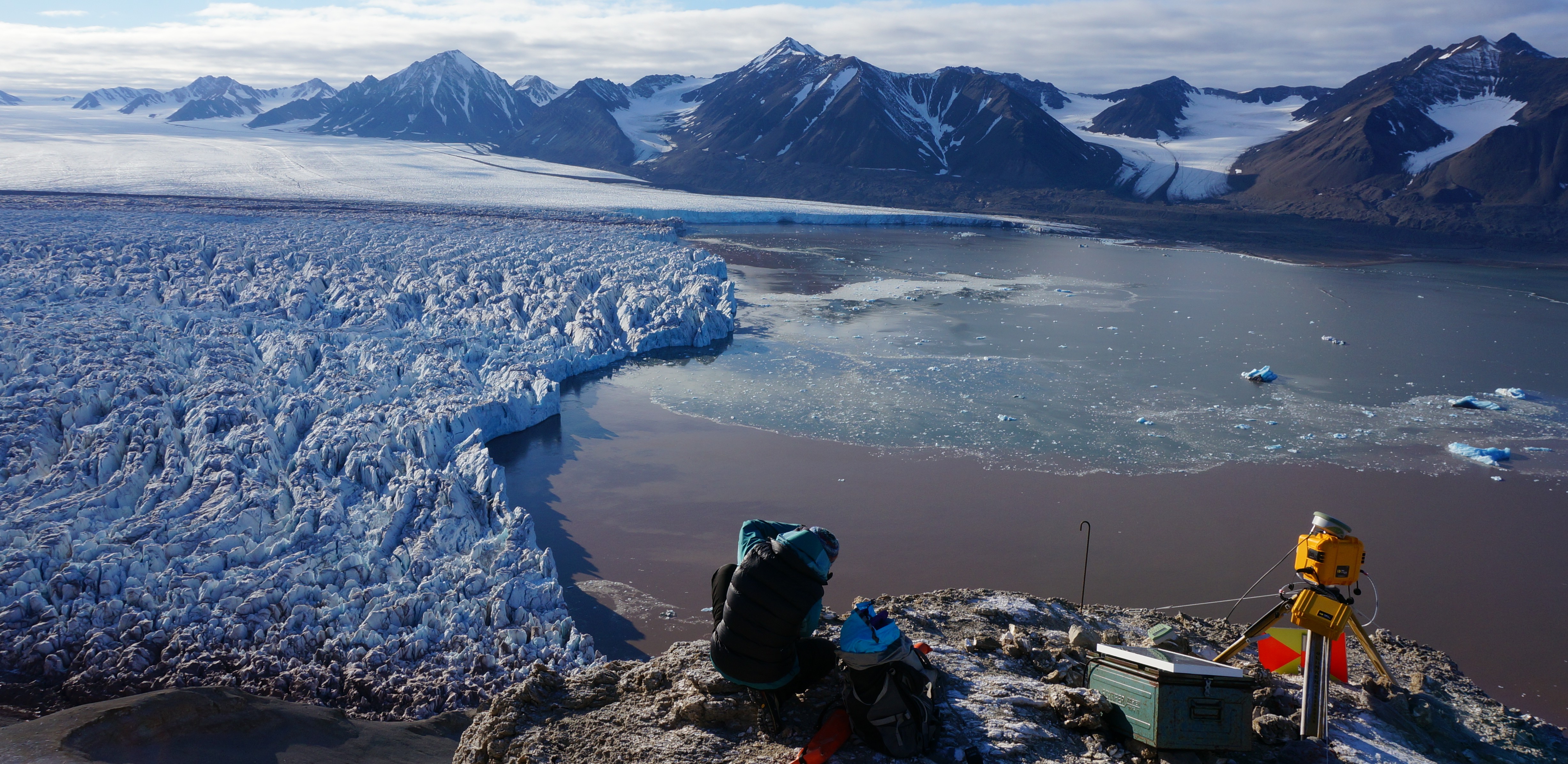PhD update: September 2015
Retrieving time-lapse cameras from Kronebreen glacier, and teaching at the University Centre in Svalbard (UNIS)

Post-doc researcher Sarah Thompson (UNIS) taking a GPS reading at camera site 2, positioned at the calving front of Kronebreen glacier, Svalbard (September 2015)
I really want to begin monthly blogs to document the progression of my PhD. In the last year and a half, my PhD has drastically changed from its initial outline and sometimes I wonder how I got to this point. How have so many ideas and different opportunities led me to THIS specific research using THIS specific set of methods.
The beginning of September was an exciting leap forward for my PhD as we retrieved our time-lapse cameras from Kronebreen which had been deployed since May, completing a second consecutive summer in the field. I hope to write more about this fieldwork in a separate blog post when I have finished the accompanying fieldwork film. For now though, I can say that it went very successfully. We retrieved all 8 cameras and found that all of them had worked - six had taken images every 30 minutes throughout the entire season and the other two had captured images for the majority of the season due to partial failures (one corrupted SD memory card and one wet battery due to a failed enclosure). I’ve started looking at the images and there is some really exciting stuff. Three cameras look at a pretty active calving terminus, and one of the cameras positioned upglacier was lucky enough to capture some large surface lakes forming and draining. In addition, the good weather meant we were fortunate enough to place one camera at the calving terminus and obtain some really detailed sequences, which is hoped will give us further insight into calving behaviours at Kronebreen. In all, the camera stayed out for 60 hours collecting images every three seconds - the SD card in the camera had to be switched every day, but it was definitely worth it!

Surface lakes on Kronebreen, captured using one of our time-lapse cameras (camera 4b). These lakes are indicative of conditions at the bed of the glacier, and can cause local velocity speed-ups when they drain
So after the success of the fieldwork at the beginning of the month, the PhD fell to the back of my mind as I was preparing to teach on Doug Benn’s Glaciers and Glaciation course (AG-347/847). The teaching involved field excursions, a full day of lectures and a day in the computer lab doing set exercises - all on photogrammetry techniques, specialising in terrestrial time-lapse photogrammetry. I found it was a pretty intimidating task at first. I’ve done presentations and one-hour lectures, but never a whole day of back-to-back lectures (and aimed at masters and PhD students). It was lucky that I got the time off my PhD to do this teaching as the preparation took up all of my time. I never fully appreciated how much time, effort and care is put into making lecture materials and exercises during my undergraduate degree. It was definitely a learning experience.
One of the most difficult things was creating an exercise that was appropriately aimed at a class of mixed abilities - something that challenges those who have encountered photogrammetry processing before, but is also accessible for those with little or no experience. I ended up tailoring an exercise based around Pointcatcher, which is a time-lapse feature tracking software that originated from Matlab but now operates as a stand-alone piece of software. This has obvious benefits as anyone from any background can use it, regardless of coding experience. It was also handy that I am in regular contact with Mike James (Lancaster University) who developed Pointcatcher, and had been working with him to iron out any bugs or limitations that I had come across. I am so grateful for his helpful advice for the exercise. He was so encouraging and supportive of using Pointcatcher for teaching.
Overall, the lectures went okay. I had great student participation and lots of good questions throughout the day. I had lots of videos and current examples which varied the lectures from a subject which can be quite dry at times. I felt like I could have been more engaging at times though - I could hear my voice slip into a boring monotone state at points, and sometimes I got my words mixed up (especially in the technical sections of the lectures) and had to ask the class if they had understood.

Students from AG-347/847 using Pointcatcher to determine the surface velocity of Kronebreen, a fast flowing tidewater glacier in Svalbard
The exercise day was reasonably successful. As predicted, some only managed the first couple of instructions, whilst others completed everything that I had set. It highlighted to me parts of the software that I should have a more in-depth understanding of, but I was able to solve problems when people came across them and explain the processes involved reasonably well I think. I even managed to take a look at one of the MSc student’s Matlab code for a different project at the end of the day… and I fixed it… in an hour… I think that is a new personal record. I’m very proud of that!
So October will be devoted to resuscitating my flatlining PhD, starting with a meeting with my supervisor before I travel back to Edinburgh for the winter. I hope to look at our new time-lapse sequences from Kronebreen, and really nail some of the core functions of the feature tracking software that I am developing with my primary supervisor - PyTrx, programmed in Python using the computer vision toolbox OpenCV. I have a lot of images now that I really should get a move on with processing. Fieldwork is over for this year. Time to knuckle down and code.
